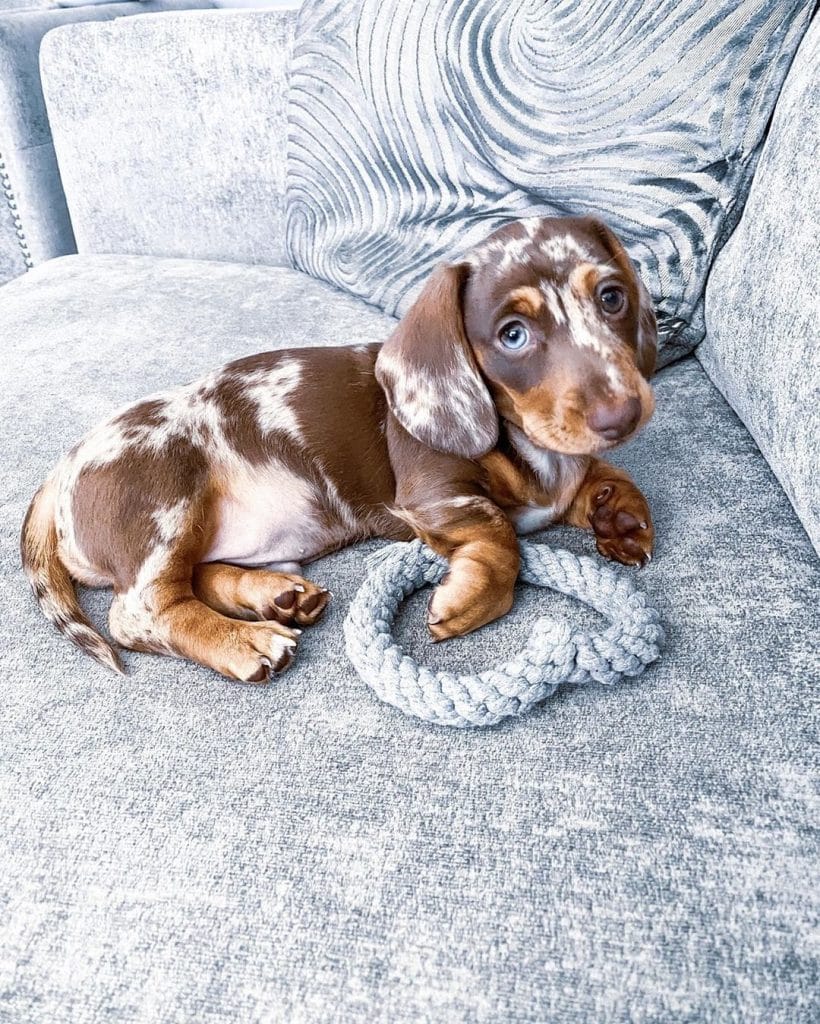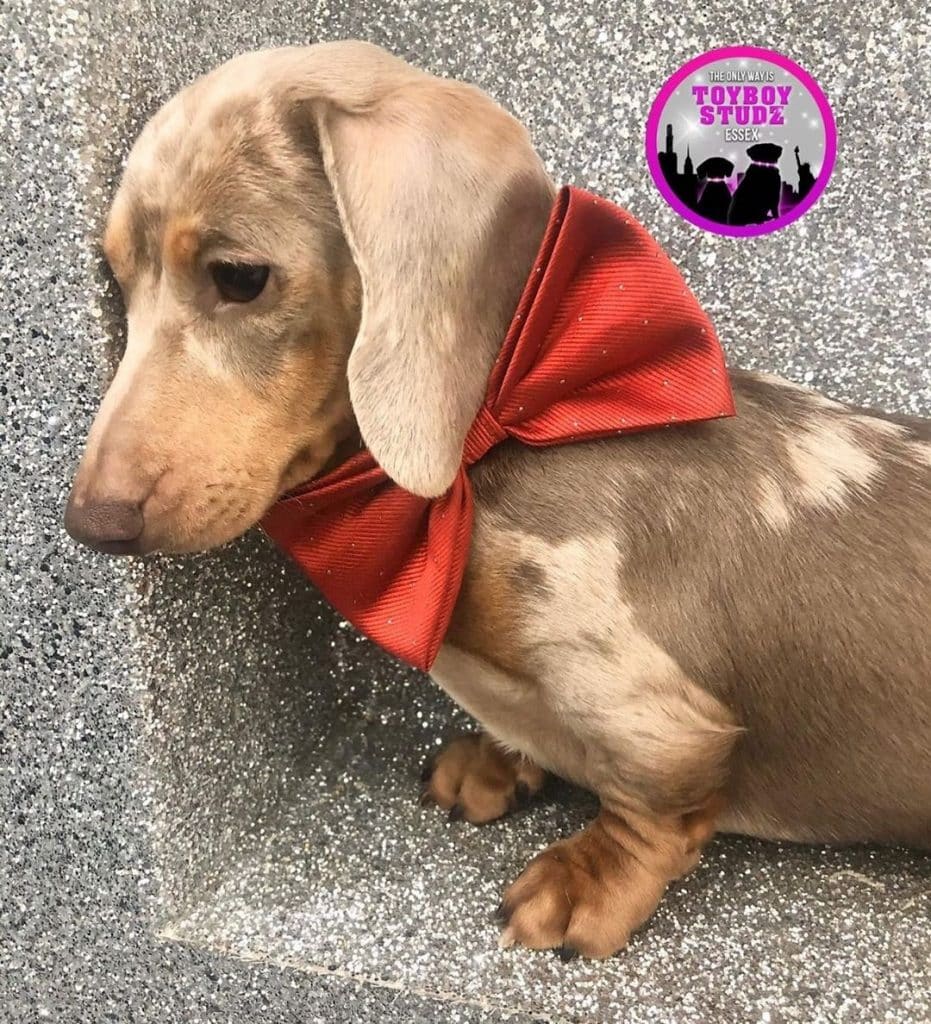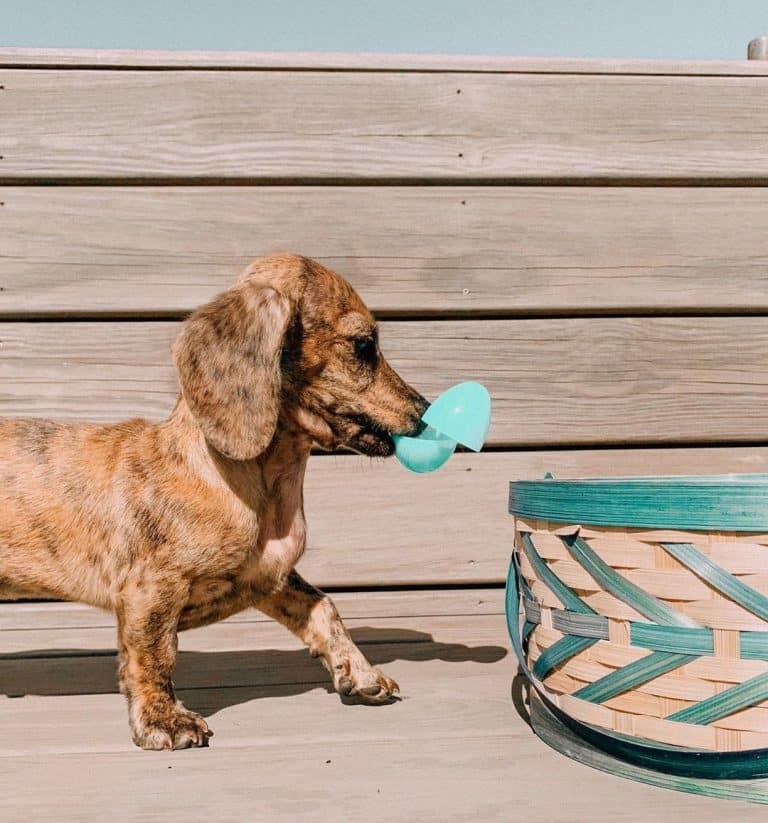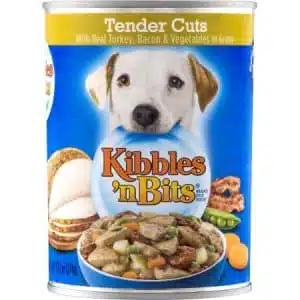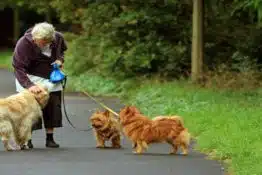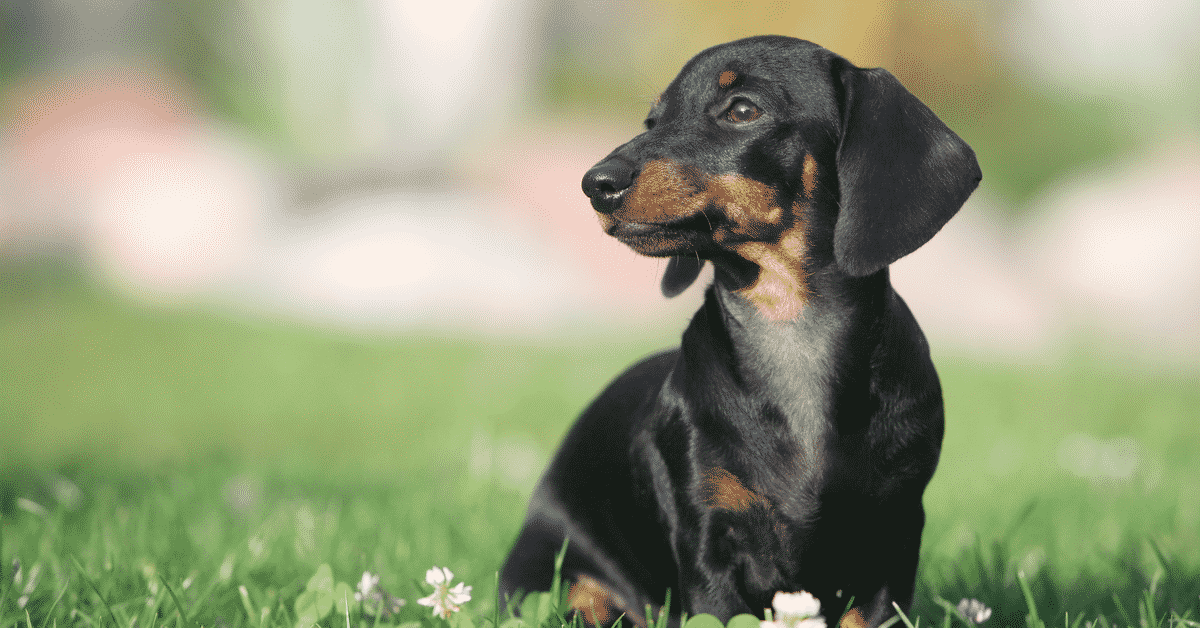
Dachshund vs Miniature Dachshund: The Battle of Wieners
Credit: robsons_at_number_10
Dachshund Vs. Miniature Dachshund: Big Vs. Small
The Dachshund —or the sausage dog, as many like to call them— is a famous purebred dog and a beloved pet all around the world. They are praised for their intelligence and sparkly personality, which earned them 12th place on the American Kennel Club’s list of the most popular dog breeds. Dachshunds come in a couple of variants. When it comes to size, they can be either Standard or Miniature. Another feature that can vary is the coat type—both Miniature and Standard Dachshund can have smooth, long, or wiry hair.
Breed History
Sausage Dogs are an old breed that can be traced back to the 15th century. They originated in Germany, and their primary purpose was to hunt small game and den animals. Dachshunds excelled at the task and were capable of hunting both below and on the ground.
At the beginning of the 19th century, hunting lost its momentum, but Badger Dogs proved to have many other talents, so their fame did not dwindle. With their loyalty to people, they became exceptional watchdogs.
It is unclear when the Miniature Dachshund developed, but it was probably around that time. People appreciated sausage dogs and kept them as companions, so a smaller variant was more appropriate in urban environments.
Dachshunds reached stardom once they had crossed the Atlantic because America fell in love with them. During World War II, they lost popularity as German name and origin were not favorable attributes. Yet, Badger Dogs made a spectacular comeback in the 1950s and remained desirable pets ever since.
The One Thing Pet Owners Regret Not Doing Until It’s Too Late
Is your pet safe?
1 in 3 pets will need emergency veterinary treatment each year and it is estimated a pet receives emergency care every 2.5 seconds in the U.S.
The average cost of treating a broken bone in dogs is $2,700. Cancer treatments? Up to $10,000.
It’s why so many pet owners say their biggest regret isn’t the vet bill—it’s not having pet insurance when they needed it most.
Ask yourself: “If an unexpected $5,000 vet bill hit tomorrow, could I afford it?”
If the answer is no, it’s time to get covered.
Take a look at Lemonade. They have a great app that actually works, they have an instant chatbot that is faster and, dare we say it, friendlier than most companies’ “real” customer service and a quick scroll through Reddit will uncover… people are really vibing with this brand.
So go check them out and take a look. It takes less than a minute.
Both Dachshunds and Mini Dachshunds are quite common, with the standard version being more prevalent in suburbs and rural areas. Miniature Dachs tends to be more of a city dog breed.
Mini Vs. Full-Size Dachshund Traits
Credit: toyboystudz
At first glance, they are quite adorable with their elongated bodies and short legs but they do serve a purpose. Because of their long spine, they are able to crawl into the dens and extract prey with success. Their long tails were used by huntsmen to drag them out of the holes, with badgers and foxes in Dachshund’s teeth.
When it comes to the jaw, Dachshunds have a mighty scissor bite, another characteristic of hunting dogs. Their paws are paddle-shaped, which means that they are pro diggers. The ears are floppy, and the muzzle is long. Dachshunds have almond-shaped eyes with an attentive gaze and a black nose.
The coat varies from short and smooth to long and wiry. The general belief is that long-haired pooches are the result of mixing Dachshunds and Spaniels. The color palette is broad, and some pups can combine different shades.
The difference between the Standard Dachshund and Mini Dachshund is only in size, and the above traits are applicable for both types. The difference in the size of a standard Dachshund compared to a miniature Dachshund is significant, with full-size weiner dogs being twice as big as the miniature version.
| Weight | Standard Dachshund: 16–32 lbs
Miniature Dachshund: 9–11 lbs |
| Height | Standard: 8–11 inches
Miniature: 5–6 inches |
| Coat type |
|
| Coat color |
|
| Shedding | Moderate |
| Eyes | Brown |
| Nose | Black |
| Ears | Floppy |
| Temperament | Active and friendly |
| Life expectancy | 12–16 years |
| Hypoallergenic | No |
| Kid-friendly | Yes (for children over five) |
| New owner friendly | Yes (with adequate training) |
| Breed recognition | Yes (American Kennel Club in 1885) |
Mini Dachshund Vs. Standard Dachshund Temper
There are no noticeable differences between the two regarding temperament and behavioral patterns. Small dogs tend to be louder and more defensive because they often feel threatened. Most experts agree, though, that Dachshunds are courageous and confident dogs with exceptional stamina and lots of feisty attitudes.
Dachshunds are strong-willed and curious, so they can be challenging to train. Even the miniature pups show signs of stubbornness. If you are a first-time owner, raising a Weiner can be a handful, so avoid them if you lack patience or check out our care tips for new dog owners.
On the plus side, Dachshunds are people-oriented and loyal. With adequate care and love, they can become cheerful companions, and bring pure joy into your life. They can get along with fellow pets and be friendly with other pooches, though some hostility may exist among dogs of the same sex.
Being territorial by nature, Badger Dogs can become heavy barkers. Even the Mini Dachshunds are quite loud and like to express their feelings as often as possible. This feature can become an issue if you live in an apartment building with lots of grumpy neighbors.
Although the size does not affect the temper, long-haired Dachshunds tend to be more mellow and easy-going. The trait probably comes from their Spaniel ancestors. If you are new to raising a pup, choose a Weiner with longer hair.
Dachshund Vs. Mini Dachshund Training
Credit: hudsonthedox
Training the Sausage Dog can be a demanding endeavor. With a will of their own, Dachshunds are rebels, so you need to start practicing with them from puppyhood. The crucial aspect of the process is to take the role of the pack leader.
Establishing yourself as the boss is the only way to get the respect of your baby. They will look for your approval in any disputes or conflicts, which will enable you to protect them. Of course, a little bit of trouble and mischief is bound to happen.
Getting a Miniature Badger Dog will not make the training easier. Mini Weenies are as opinionated as their larger cousins. If you would like a less demanding pet, then opt for the pups with wiry hair.
Successful training should include:
- Teaching commands
- Socialization
Commands
Complying with the commands is essential for the safety of your baby. Dogs must react to basic instructions like Stop or No. In urban areas with lots of traffic, this is even more important. If it’s your first time training a pooch, follow these guidelines for maximum results:
- Set up a reward system. Dogs react well to positive reinforcement, so if your pup does something right, give them a pat, a treat, or a gift. You would be surprised how far they will go for a sweet and a kind word.
- Use training collars. They are not torture devices. Collars are an excellent aid in the process, and you shouldn’t hesitate to get one, especially if you haven’t trained a dog before.
- Keep the sessions short. Dogs have a short attention span, so don’t expect them to be able to focus for too long. It’s better to have frequent but brief and effective bouts.
Socialization
Since they are not meant to go through their life solo, dogs will never be happy unless adequately socialized. Dachshund can become moody, aggressive, or develop separation anxiety if you don’t integrate them into the community.
Make sure to include the following in your routine:
- Playing with other dogs
- Meeting and interacting with strangers
- Visiting and exploring new places
The above activities will develop the more amicable side of the Sausage Dog personality. With their positive traits at the forefront, your pooch will be relaxed and happy. And so will you.
Full-Size Weenie Vs. Mini Weenie Grooming Rituals
The grooming of your furry friend depends more on the coat type than the size. Dachshunds are not challenging to maintain, especially if you opt for a short-haired Weenie.
For the Sausage Dog with a short and smooth coat, a proper brushing once a week will suffice. Long and wiry hair requires a thorough session with a pin brush, as well as occasional bathing. Shedding is not a big issue with Dachshunds, but it’s better to have a deshedder and remove excessive undercoat hair twice a month. Make sure to use only all-natural dog shampoos.
Both Mini and Standard Weiners will need nail clipping. If you are unsure how to do it, take your baby to a doggy beauty salon. Also, trimming the coat is not a bad idea, at least twice a year.
Teeth are crucial for every dog. To keep them healthy, brush as often as possible, and introduce any of the top 10 best dog dental chews for gums.
With their floppy ears prone to infections, make sure you clean them with wipes or rinse with an appropriate solution. You should pay attention to the eyes and clean or rinse any impurities to avoid conditions like conjunctivitis.
Remember that grooming is not just about health and beauty. These rituals help establish mutual trust and build a strong bond with your baby.
| Brushing frequency | Brushes for Dachshunds |
| Weekly |
|
Standard Dachshund Vs. Miniature Dachshund Appetite
Credit: noodlethedachie
All Dachshunds are closeted overeaters, so you will have to pay attention to their appetite. Miniature Weenies will need less food than the full-size variant, but you should stick to the best dry dog food for small dogs in both cases.
All pooches are mad about the worst dry dog food as we are mad about junk food. You should restrict from giving in to their preferences and always choose high-quality products. If in doubt, try any of the following:
- Wellness Core Original Grain Free Dry Dog Food
- Hill’s Science Diet Dry Dog Food, Chicken Meal, Barley & Rice Recipe
- Royal Canin Canine Health Nutrition Adult Beauty Canned Dog Food
The menu should be versatile, so introduce the best canned dog food, or cook a delicious doggy meal yourself. For little munchkins, try to find the best puppy food brands on the market. As your pup grows older, adjust their diet with the best senior dry dog food.
Both Standard and Miniature Dachshunds are prone to obesity, so doggy sweets and treats can become an issue. Don’t let them overindulge and stay clear of the worst dog treat brands. They will only make your puppy overweight, no matter how delicious they may be.
Mini Dachshund Vs. Standard Dachshund Exercise Routine
Any type of Dachshund will be active and outdoorsy. Their hunter background requires a lot of activities to ward off all that energy. If you are more of a couch potato, avoid Weenies because they can become impossible if you keep them inside for too long.
You should include the following into your daily routine:
- Regular 60-minutes walks with plenty of off-the-leash time. Dachshunds are curious, and they need to sniff and explore on their own.
- Mental challenges both inside and outside. Teach them tricks or get them an interactive toy. Dachshunds are intelligent and need mental stimulation as much as they need physical activity.
- Playtime with other dogs. It is the best way to keep them tired and peaceful. Never forget that the only calm dog is the exhausted dog.
| Activity level | Recommended miles/week | Activity minutes/day |
| High | 7 miles | 60 minutes |
Health Concerns of Standard and Miniature Dachshunds
Both types share the same potential risks. Although Dachshunds are not too sensitive, you should always be cautious and aware of the health issues that come with this breed.
Badger Dogs tend to suffer from back problems because of their elongated bodies. Jumping is not a favorable activity for them, so try to prevent it as much as possible. If you and your pooch share a bed, or if they like to sleep on the sofa, set up a ramp, so they can get off without leaping.
Another common problem is their obsession with food. If Dachshunds gain weight, the potential risks of back injury become more significant, so keep them in good shape. With possible gastrointestinal discomfort, you have one more reason to stick to a well-balanced diet.
With good food and proper care, most dogs will remain healthy and active for a long time. As they age, the visits to the vet should be more frequent, and you should take blood and urine tests more often. Complete physical checks are another excellent way to stay ahead and prolong your Doxie’s lifespan.
Less frequent issues that this breed can suffer from are seizures and skin problems. If your pooch suffers from dry skin, consider adding supplements to their diet.
| Major concerns | Minor concerns | Occasional tests |
|
|
|
Full Size and Miniature Dachshunds as Family Members
Despite their feisty attitude, both Standard and Miniature Dachshunds can be wonderful pets. With the love and devotion they have for humans, you will get a friend for life if you decide to let a Weenie into your family.
Badger Dogs are adaptable, so they will appreciate the snow and the heat and enjoy both country and city life. If you happen to have a small apartment downtown, it may be better to opt for the Miniature Weiner. For those of you who have a big house with a backyard, Standard Dachshund is an excellent choice.
Speaking of yards, don’t forget that Sausage Dogs are keen on digging. If you don’t want your garden plowed every day, try designating an area where your pooch can dig freely. That way, you can keep the rest of the yard mostly intact.
Dachshunds can get along well with other pets if raised properly. The same goes for children. If your kids are under five, it may be better to wait until they are more sensible and can understand boundaries. Dogs are not toys, but small children can have a hard time complying with that fact.
All Weiners are vocal dogs, so you should be ready for some constructive conversations, but also potential quarrels with your pup. Even Mini Dachshunds have a loud voice of a much larger dog, so focus on controlling it during training.
Badger Dogs tend to be mischievous, and you should not leave them alone for too long. They can be cruel to the furniture, and just because your Weenie is miniature, it doesn’t mean that they can’t cause havoc.
Our Top Three Reasons For Owning a Weenie
- They are easy to maintain and groom.
- They are intelligent and friendly.
- They are affectionate and loyal.
Our Top Three Reasons Against Owning a Weenie
- They are hard to train.
- They are not good with children under five.
- They require a lot of physical activity.
Adorable Dachshund Cross Breeds
Although Badger Dogs are not on the list on the top 10 world’s most expensive dog breeds to own, they are not cheap either. If you are keen on getting a Sausage Dog, we advise you to hit a local shelter and adopt an abandoned Weenie. Making a lonely pooch happy is rewarding and humane. For additional ideas, check some of the best dog breeds to adopt.
Dachshunds mix well with other breeds, and you can check some of the hybrids on the list. It’s hard to say which one is more adorable.
Best Dog Food for Dachshund

- Essential, high-quality protein for healthy muscle development, and carbs for energy for an active life.
- Calcium, phosphorus and essential vitamins for strong bones and teeth.
- Glucosamine is added for joint health and mobility support.
- Vitamins, chelated minerals and antioxidants contribute to your pup's immune system health.
- No corn, wheat, soy or chicken (or poultry) by-product meals.
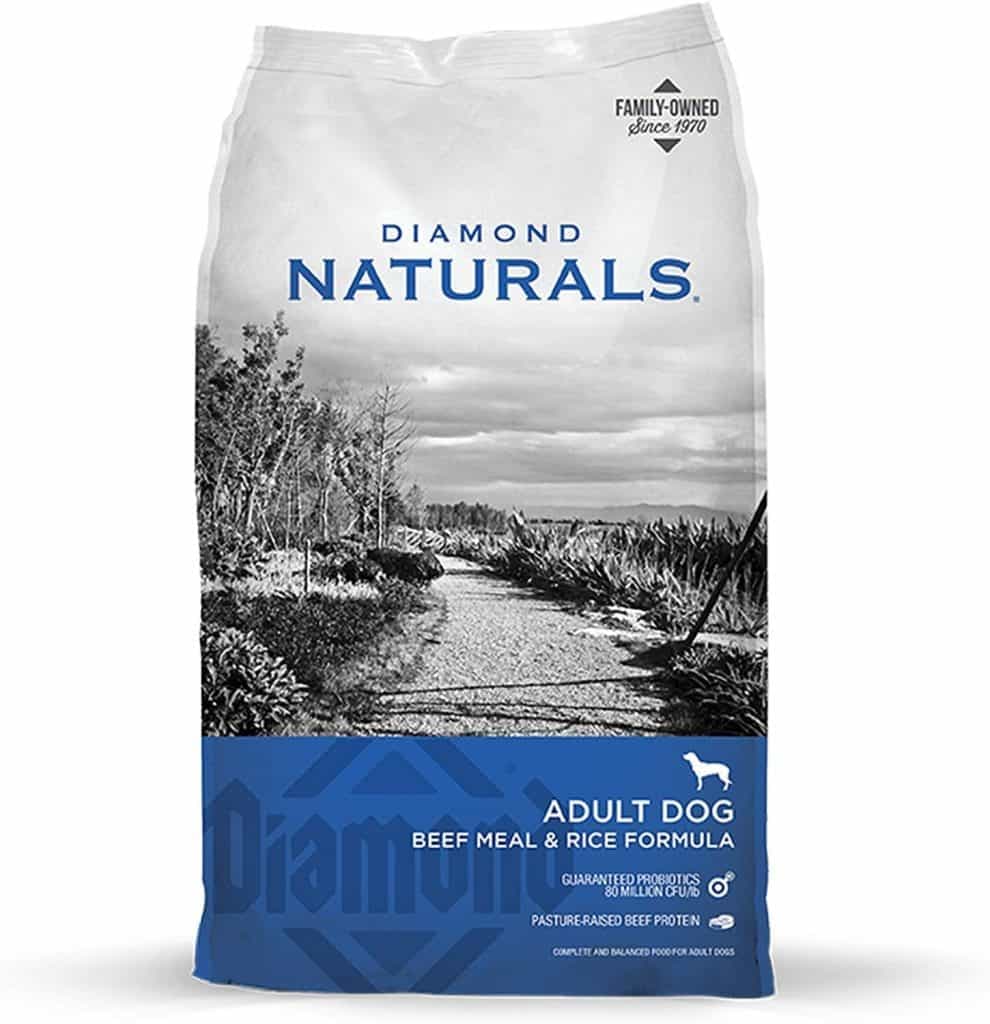
- Made in the USA by a family-owned company using quality ingredients from trusted domestic and global sources.
- With real pasture-raised beef protein as the #1 ingredient, this recipe helps support bones, joints and lean, strong muscles.
- Beef protein provides energy and muscle building blocks, omega fatty acids promote skin and coat health and superfood fruits like blueberries and oranges offer vitamins and minerals.
- Each serving includes species-specific K9 strain proprietary probiotics, plus antioxidants and prebiotics to help support healthy digestion, immune system health and overall wellness.
- Made without corn, wheat, artificial flavors or colors.
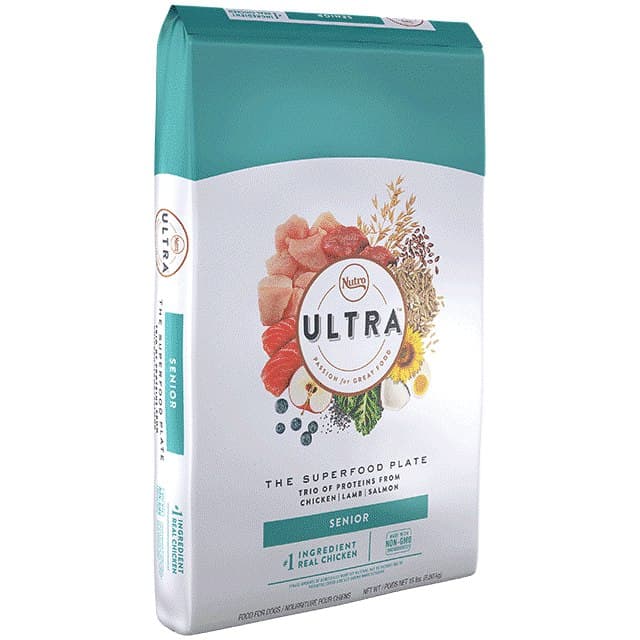
- Protein-rich formula features chicken, lamb, and salmon—and chicken is the first ingredient!
- Contains a blend of 15 superfoods including coconut, chia, kale, and blueberries that promote coat and skin health.
- Recipe specially formulated for senior dogs using only high-quality, real ingredients to provide complete and balanced nutrition.
- Ingredients are sourced from trusted farmers and rigorously tested for quality and food safety.
- No artificial preservatives, flavors, or colors, and chicken by-product meal, corn, wheat, and soy protein free.
FAQs: Dachshund vs. Miniature Dachshund
1. What’s the difference between a Dachshund and a Miniature Dachshund?
The main difference is in size. Dachshunds are a small breed, and there are also Miniature Dachshunds, which are smaller than the standard Dachshunds. Standard Dachshunds typically weigh between 16-32 pounds, while Miniature Dachshunds usually weigh around 11 pounds or less.
2. How big do Mini Dachshunds get?
Miniature Dachshunds generally weigh around 11 pounds or less and stand about 5-6 inches tall at the shoulder.
3. What’s the difference between a Dachshund and a Miniature Dachshund?
The primary difference is in size, with Miniature Dachshunds being smaller than standard Dachshunds. Temperament and other characteristics are generally similar.
4. Why do some people consider Dachshunds the worst breed?
Breed preferences are subjective, and what some may perceive as challenging traits in Dachshunds, others may find endearing. Like any breed, Dachshunds benefit from proper training, socialization, and care.
5. How big does a Mini Dachshund get?
Mini Dachshunds typically weigh around 11 pounds or less and stand about 5-6 inches tall at the shoulder.
6. How big does a Miniature Dachshund get?
Miniature Dachshunds usually weigh around 11 pounds or less and are smaller than the standard Dachshund.
7. How much are sausage dogs?
The cost of Dachshunds often referred to as “sausage dogs,” varies based on factors such as breeder reputation, lineage, and geographic location. On average, prices can range from a few hundred to over a thousand dollars.
8. How many teeth does a Miniature Dachshund have?
Like all adult dogs, a Miniature Dachshund typically has 42 teeth, including incisors, canines, molars, and premolars.
9. How much should a Mini Dachshund weigh?
A Miniature Dachshund’s ideal weight is around 11 pounds or less, but individual dogs may vary. It’s essential to monitor their weight to ensure they maintain a healthy size.
References
- https://en.wikipedia.org/wiki/Dachshund
- Claire, Roxanne St. Dachshund through the Snow. South Street Publishing, 2019.
- Brown, Nathan P., et al. “Development of a Canine Rigid Body Musculoskeletal Computer Model to Evaluate Gait.” Frontiers in Bioengineering and Biotechnology, vol. 8, Nov. 2020, doi:10.3389/fbioe.2020.00150.
80% of Dogs Develop Arthritis or Joint Pain by 7 Years old – Here’s How to Protect Them
Most of us train our dogs when they are puppies to jump up on furniture. We think it’s harmless (and easier than always lifting them), but for dogs, couches and beds are very high compared to the size of their bodies.
Every time they jump it compresses their back and applies enormous force to their joints.
It’s no wonder that an incredible 80% of dogs experience arthritis or joint pain by only 7 years old.
Luckily, there is a vet-recommended solution.
It’s the PawRamp by Alpha Paw. An adjustable ramp that allows dogs to safely get on and off couches and beds. PawRamp makes joining you in bed or on the couch effortless and fun.
As a bonus, you can use code SAVE35 to get $35 off the PawRamp today.

